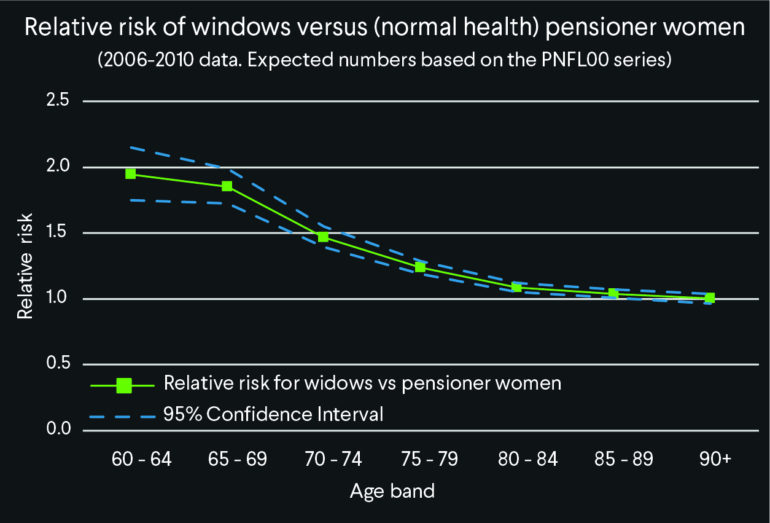In this regular column, Club Vita’s longevity experts will help you visualize the often abstract world of longevity risk by introducing some of their favourite charts.
In this edition Longevity Consultant Erik Pickett presents a chart exploring the so-called “grieving widow effect”.
Question:
Does the chance of dying increase after the loss of a partner?
Answer:
Yes, our UK data shows a distinct increase in mortality rates for female surviving spouses (widows) compared to other female retirees. This effect is most notable at younger ages and immediately after the death of a spouse.
The chart below shows the relative risk* of widows dying in the next year compared to other female retirees in the Club Vita data set. For all ages, the widows have a higher chance of dying in the next year than other female retirees.
We also looked at the relative risk of widows in the first year of bereavement compared to widows after the first year. This showed an increased level of mortality of around 10-15% in the first year (a relative risk of between 1.10 and 1.15). This partly explains why the greatest relative risk of widows over other retirees comes at the youngest ages (where you find more cases of recently bereaved widows).

Key takeaways
- Surviving spouses exhibit an elevated risk of dying compared to standard pensioners in the Club Vita data set.
- This effect is noticed most at younger ages, partly driven by the fact that the elevated chance of dying is greatest in the year following the death of a spouse.
Whether it’s due to loss of companionship, support in the home or the effects of a broken heart, the grieving widow effect does indeed seem to exist. If you are interested in this subject, you can read more in our research paper, Grieving Widows: exploring excess mortality following bereavement.
The key question for pension plans and insurers is:
Are you allowing for this effect when calculating longevity assumptions for surviving spouses?
What do you think?
Please post your questions in our Friends of Club Vita discussion group on LinkedIn.
*Relative risk is a statistical measure showing the increased (or decreased) chance of dying of a certain group compared to another group. A relative risk greater than 1 signifies a greater chance of dying for the first group, whereas a relative risk less than 1 signifies a smaller chance of dying.




